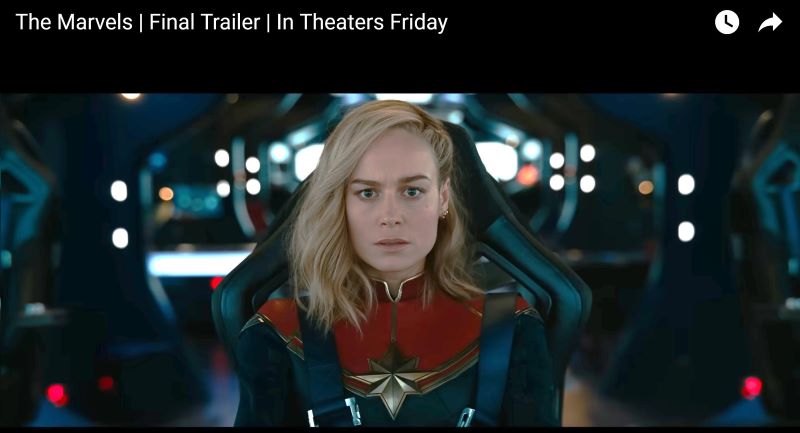
Once considered a strength, the Marvel Cinematic Universe that interconnects movies and comic books has become a drag. New theatrical film “The Marvels” generated a disappointing $47 million over the Nov. 10-12 premiere weekend, the lowest of any big-budget movie in the modern era of adapting Marvel comic books to cinema screens. And stumbles have become a trend in which three of the bottom six since 2008 occurred in the past three years (see table, below).
“Marvels” contained references to sibling TV series and is a sequel to 2019 theatrical “Captain Marvel,” which by comparison opened with a hefty $153 million domestically. For another comparison, nine other recent Marvel comic adaptations averaged $136 million domestic premiere weekends. That raises the question of if the Marvel Cinematic Universe (MCU) has become too inbred and self-referential.
The live-action, female cast-driven “Marvels” stars Brie Larson and its audience classification is PG-13. The action/adventure fantasy film is distributed by Walt Disney Studios, whose parent owns the Marvel comic book empire, which it purchased in 2009.
Lowest Premieres for Marvel-Film Adaptations in Modern Era*
| $47m | The Marvels | 2023 | |
| $55.4m | The Incredible Hulk | 2008 | |
| $64m | Captain America: The First Avenger | 2011 | |
| $65.7m | Thor | 2011 | |
| $71.3m | Eternals | 2021 | |
| $75.4m | Shang-Chi and the Legend of the Ten Rings | 2021 |
The $47 million boxoffice opening for “Marvels” makes profitability for the $220 million-270 million budgeted movie uncertain and renews concerns of “franchise fatigue” for Marvel film adaptations, which used to automatically mint big money. The modern Marvel Cinematic Universe has spawned 33 films that grossed over $30 billion in global boxoffice, mostly distributed by Disney.
Marvel misfires at the cinema are now regular occurrences. “Marvel has been showing recent signs of wear and tear, but ‘Ant-Man and the Wasp: Quantumania’ and ‘Eternals’ weren’t labeled as disappointments until the end of their theatrical runs,” writes Rebecca Rubin in Variety. “‘The Marvels’ is concerning because it’s the rare misfire out of the gate for the MCU.”
In mid-October, Hollywood audience research tracking forecast a $75 million-80 million premiere opening, and then forecasts were quickly lowered to about $50 million, which proved accurate. “Marvels” was a rare Marvel adaptation where audience tracking estimates went down, not up, as actual premiere arrived.
To put the $47 million opening in perspective, sleeper cinema hit “Five Nights at Freddy’s” is celebrated with a $80 million premiere weekend of domestic boxoffice, and that horror film cost just $20 million to produce. That’s about 9% of the production cost, at the low-end of estimates, of special-effect laden “Marvels.”
Looking beyond boxoffice, professional reviewers were neutral to negative, saying the “Marvels” story is trite, familiar and too entwined to the Marvel Cinematic Universe. Fans are a bit more positive, but that’s still poor by Marvel standards where aficionados are usually in rapture.
Here’s a case study of what happened.
The Marvel Cinema Universe churns out too many films with similar plots, as well as TV shows. “Marvels” contains cross references to Disney+ streaming TV series “WandaVision” and “Mrs. Marvel,” in an obvious attempt to coax fans to become engrossed in the brand. “Marvels” also faces a balancing act with a female cast when the core audience for comic book adaptations is fanboys, which is a male demographic. A diversity trend is sweeping across Hollywood putting pressure on studios to take greater risks in casting.
From prerelease audience tracking surveys, Disney knew that “Marvels” was headed for a disappointing boxoffice so it mounted a last-ditch marketing blitz for which the centerpiece was a pricey 2-minute TV commercial on “Monday Night Football.”

The 120-second commercial shoe-horned in images of characters from prior movies to link “Marvels” to past blockbusters. For example, there’s a fuzzy-gauze view of actor Robert Downey Jr. from the “Avengers” movie series (the first in 2012 grossed a staggering $1.5 billion worldwide!). The gauze created a flashback effect.
ESPN cable network’s “Monday Night Football” attracts an average of 12 million viewers and each 30-second commercial costs about $550,000 (“Marvels” strung together four commercial slots, or a $2.2 million media buy). The opening weekend generated unit cinema sales of about 3.3 million tickets.
Further, Disney held a pricey press premiere event in Las Vegas, which included a takeover of the mammoth new concert arena the Sphere. A “Marvels” image was projected externally on the 366-foot high Sphere, in an impressive promotional stunt.
“Marvels” was hampered by the now-settled actors strike that meant on-screen star talent like actress Brie Larson couldn’t do publicity in the weeks leading up to theatrical premiere. The strike diminished its presence at the summer Comic-Con fan convention, which ordinarily is a prime platform for publicity.
The “Marvels” $47 million in domestic boxoffice is a disappointment but not an unmitigated flop like a $20 million opening would have been.
A professional film critic tweeted a film reaction after the premiere, “Not great but far from a disaster,” which is perhaps the best summary. Reviews from professional critics ran a wide range.

“Marvels” is praised for its crisp 1 hour 45 minute running time, a refreshing conciseness in an era where big movies continue for three hours or more.
On the other hand, New York Post columnist Johnny Oleksinski laments: “Ostensibly made for the average moviegoer, ‘The Marvels’ requires homework for a basic understanding of its plot.”
“It felt like a Disney” made-for-TV movie,” one fan posted. “It was rough. Had a few good action scenes though. Only 15 people in our theater. Kind of a bummer.”
Note that pre-MCU adaptation “Howard the Duck” in 1986 opened with less boxoffice, but it predates the modern era. “The Incredible Hulk,” which premiered in 2008 with a bit more than “Marvels,” marked the start of the modern era of MCU with 33 films. And “Hulk’s” boxoffice would be higher if adjusted for inflation.
Implications from comic book movie burnout today with “Marvels” weighs heavily on Walt Disney Co., as Marvel owner and distributor of most Marvel film adaptations. The $89-billion-annual revenue entertainment/media behemoth relied on Marvel films as piñatas for years from which money automatically spills out. The only question was how much money? Now, they shape up as a risk and a drain.
Related content:
Leave a Reply